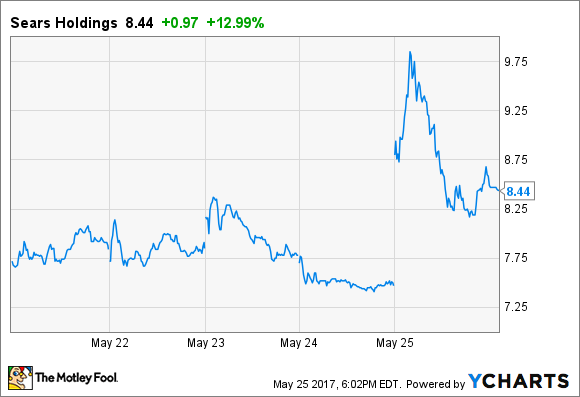On Thursday morning, struggling retail giant Sears Holdings (SHLD +0.00%) reported extremely weak results for its fiscal first quarter, just as it had predicted it would last month.
Investors were apparently expecting an even worse earnings report. Sears Holdings stock briefly soared more than 30% on Thursday, before moderating back to close with a still-considerable gain of more than 13% for the day. However, there were really no bright spots in the earnings report. All signs still point toward an eventual bankruptcy filing for Sears.
Sears Holdings Stock Performance, data by YCharts.
Sales and earnings both plummet
Sears Holdings' revenue plunged 20% year over year for the quarter, which ended April 29, falling to $4.3 billion from $5.4 billion. The company has been closing Sears and Kmart stores at a rapid pace recently. In early January, it announced that it would close 150 stores by the end of March. In the past few months, Sears Holdings has made plans to close at least 30 more.
Store closures accounted for about half of last quarter's revenue decline ($552 million). But the company has also experienced huge comp sales declines at its remaining stores. Comp sales fell 11.2% at Kmart and 12.4% at Sears in Q1.
Sears Holdings did post a profit last quarter thanks to a big one-time gain related to the sale of the Craftsman brand. But on an adjusted basis, its losses widened year over year.
Several media outlets reported that Sears Holdings' revenue and earnings results beat analysts' estimates, thus explaining the stock pop. However, there are only two Wall Street analysts still covering Sears. Furthermore, Sears' business is eroding so quickly that it's hard to predict the magnitude of the decline in any single quarter.

Sales plunged 20% year over year at Sears last quarter. Image source: Sears Holdings.
What we can say is that Sears' comp sales decline was right in line with the 11.9% estimate the company provided in late April. And its adjusted earnings before interest, taxes, depreciation, and amortization tallied to a loss of $222 million -- near the bottom of the guidance range provided a month ago.
Cost cuts aren't working
As Sears Holdings' sales have evaporated in the past few years, management has repeatedly turned to cost-cutting to keep the ship afloat, and it has stuck with that strategy in 2017. In February, the company set a target for the year of cutting annualized costs by $1 billion. In April, it increased that target to $1.25 billion.
Unfortunately, this is too little, too late. Gross margin -- the amount of money available to cover operating expenses -- declined by $247 million year over year last quarter. That's equal to roughly $1 billion on an annualized basis, offsetting 80% of Sears Holdings' planned cost cuts.
Of course, Sears won't realize the full $1.25 billion of cost savings this year. As of now, it has "actioned" just $700 million of annualized cost savings. As a result, barring a remarkable sales turnaround, Sears is on pace to report a year-over-year increase in losses during 2017, despite slashing costs to the bone.
Cash flow problems are getting worse
Finally, a close look at Sears' financial statements indicates that cash flow remains deeply negative.
In the "highlights" section at the top of its Q1 earnings release, the company stated that it paid down approximately $418 million of term loans during the quarter. However, buried later in the press release was the acknowledgment that Sears incurred $551 million of short-term borrowings in Q1. Unrestricted cash also declined by $50 million sequentially.
Thus, net debt actually increased by nearly $200 million last quarter, despite the fact that Sears received $765 million during the quarter from asset sales, primarily from the Craftsman deal. Free cash flow was around negative $900 million, compared to negative $762 million a year ago. This puts the company on track to burn another $1.5 billion to $2 billion of cash this year.
No real reason for hope
Sears Holdings' management continues to claim that the company has ample resources at its disposal to complete a turnaround. However, its earnings trajectory has been deteriorating in recent years, casting grave doubts on whether Sears will ever return to profitability.
Additionally, there are increasing signs that the company is running short of valuable assets to sell. While Sears Holdings still owns more than 350 properties, at least 90 of these have been used as collateral for loans; Sears has pledged other real estate assets as collateral for its pension liabilities. Meanwhile, the board has received bids exceeding $700 million for more than 60 properties it is looking to sell -- an average of about $12 million per property -- indicating that Sears has already sold its best assets.
Depending on how patient its vendors and lenders are, Sears Holdings may be able to stagger on for another two or three years. But based on its recent track record, its chances of surviving beyond that look pretty slim.







